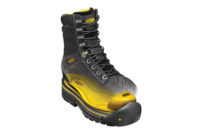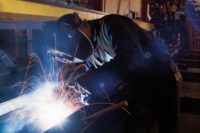Regulatory requirements
The first step toward compliance is knowing which regulations you must meet. Three OSHA regulations are used as the basis of requiring flame-resistant clothing:1. OSHA’s 1910.269 Maintenance Standard applies to electric utilities and industrial co-generation plants when maintenance is performed on existing facilities. The maintenance standard mandates that personnel who work around energized parts must not wear clothing that, if exposed to an electric arc, could contribute to the extent of burn injury. In simple terms, this means that the clothing cannot ignite, so wearing polyester, nylon rayon, or acetate (unless FR treated) is out of the question.
2. OSHA’s 1910.132 General Duty Clause requires employers to identify risks and protect employees from hazards in the workplace. The rule applies to many types of personal protective equipment, and has been used to cite employers that did not require the use of flame-resistant protective apparel.
3. OSHA’s 1910.119 Process Safety Management Regulation requires employers to assess risk throughout the entire manufacturing process to ensure that the process is safe. While the standard does not specifically require FR clothing, OSHA has used this standard more frequently than the General Duty Clause as the basis of citing employers for not requiring FR clothing.
Performance specifications
Once you know the standards you’re required to meet, it’s important to know the differences between the performance specifications related to the flame-resistant clothing you will provide for employees.- ASTM’s F1506-98 standard performance specification for clothing worn by electric workers requires the fabric to be flame resistant, which means it won’t ignite or continue to burn after exposure to an ignition source. The standard is currently being revised to include the requirement of reporting an Arc Rating.
- ASTM’s F1891-98 standard for arc and flame-resistant rainwear applies to flame-resistant, waterproof materials used in rainwear. These garments can be made from coated or laminated fabrics. The standard is currently being revised to include a fabric flammability test more suitable to coated fabrics.
- NFPA’s 2112-XX standard for flame-resistant garments for protection of industrial personnel against flash fire is currently under development and will be the first U.S. standard that specifically addresses the need for industrial flame-resistant uniforms. It’s scheduled to be finalized in 2001.
-
NFPA’s 2113-XX standard regarding the selection, care, use and maintenance of FR clothing, which is also under development, will serve as a sort of user’s guide for industrial flame-resistant clothing. It addresses topics such as purchasing, cleaning, repairs, storage, decontamination, retiring garments and proper use procedures. This standard will require that garments be certified to NFPA 2112.
Test methods
While it’s good to know the various performance specifications, it is meaningless unless you know the test methods used to determine whether fabrics meet these specifications.Meeting specifications for clothing worn by electric utility workers
ASTM’s F1506-98 fabric specification for clothing worn by electric workers relies upon the FTM 5903.1 Vertical Flammability Test, which determines whether a fabric will ignite and continue to burn after exposure to an ignition source. The test method sets criteria on how the test should be conducted (sample size, number of trials, type of flame, etc.), but does not establish performance requirements. To pass this test and be included in ASTM’s Fabric Specification for Clothing Worn by Electric Workers, the garment must have a vertical flame test maximum of two seconds afterflame and six inch char length when it is new and after 25 home launderings.
Also pending inclusion in F1506 is ASTM’s F1959-99 Arc Thermal Performance Value Test, which measures the amount of thermal protection a fabric would give a wearer if the person was caught in the vicinity of an electric arc. The ATPV is defined as the arc energy required to cause the onset of second-degree burn when a person is wearing the fabric. The higher the ATPV, the more protective the fabric.
This test is only conducted on flame-resistant fabrics to measure protection from the heat and flame by-products of an electric arc. It does not indicate any protection from contact with an electric arc.
Meeting specifications for arc and flame resistant rainwear
ASTM’s Standard for Arc and Flame-Resistant Rainwear (F1891-98) relies on the Vertical Flame Test and the Arc Thermal Performance Values described above. To pass the test and be included in the rainwear standard, garments must have a Vertical Flame Test with a maximum two seconds afterflame and six-inch char length when it is new and after 25 washings.
Meeting specifications for flame-resistant garments for industrial personnel
To meet the pending NFPA 2112-XX standard regarding flame-resistant garments for the protection of industrial personnel against flash fires, garments must meet several tests. Aside from the Vertical Flame Test mentioned above (requirements for this specification are a vertical flame test with a maximum two seconds afterflame and four inch char length when it is new and after 100 launderings), other tests include:
ASTM D4108-87 Thermal Protective Performance (TPP) Test, which measures the amount of thermal protection a fabric would give a wearer in the event of a flash fire. The TPP is defined as the energy required to cause the onset of second-degree burn when a person is wearing the fabric. The higher the TPP, the more protective the fabric. To meet the criteria of this standard, fabric must possess a minimum TPP of six-inch spaced configuration and a minimum TPP of three-inch contact configuration.
Heat resistance or thermal stability requirements mandate that the fabric will not melt and drip, separate or ignite in a 500°F oven for five minutes. Thermal Shrinkage Resistance requirements mandate that fabric will have a maximum ten percent shrinkage after being in a 500°F oven for five minutes.
Garments must also pass the ASTM Flash Fire Mannequin Test for inclusion in the NFPA 2112-XX category. This test is a full-scale mannequin test designed to test fabrics in completed garment form in a simulated flash fire. A mannequin, with up to 122 heat sensors spaced around its body, is dressed in the test garment, then exposed to a flash fire for a pre-determined length of time. Tests are usually conducted at heat energies of 1.8-2 cal/cm2sec, and for durations of 2.5 to 4.5 seconds. Results are reported in percent body burn, with a maximum of 50 percent total body burn indicated when a standard coverall is tested for three seconds with underwear worn under the test garment.
Sidebar: Who sets the standards?
Performance standards are developed by a number of government and non-profit organizations to establish guidelines for protective equipment and procedures for working in hazardous areas. While these standards are not law, they sometimes gain the force of law. Frequently, OSHA and other law-making bodies incorporate voluntary compliance standards into new laws and rules.Some standards-setting organizations in North America that commonly address protective clothing are:
American Society of Testing of Materials. ASTM publishes both performance specifications and test methods for evaluating protective clothing and equipment. Participants in ASTM are volunteers from industry, testing organizations, and users who have an interest in the topic. Standards and test methods are published by ASTM and renewed every five years.
National Fire Protection Association. NFPA writes voluntary compliance standards related to the Fire Service and other industries. Participants who serve on the committees that write standards are volunteers representing manufacturers, users, testing and special experts. NFPA standards are subject to public comment before publishing, and are renewed every five years.
Canadian Government Standards Board. CGSB is a voluntary compliance organization that is sponsored by the Canadian government. As with NFPA, participants are volunteers representing manufacturers, users and testing, and each committee must have balanced representation. However, only Canadians can be voting members on each committee.


